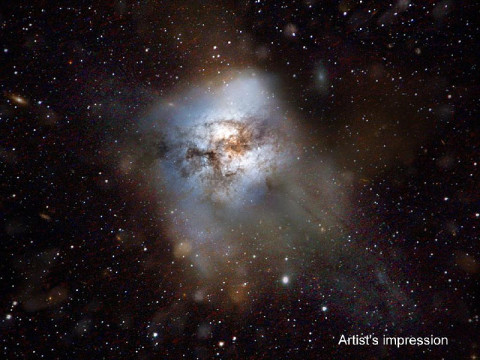Written by Whitney Clavin
NASA’s Jet Propulsion Laboratory
 Pasadena, CA – Astronomers, including Matt Bradford, Jamie Bock, Darren Dowell, Hien Nguyen and Jonas Zmuidzinas of NASA’s Jet Propulsion Laboratory, Pasadena, CA, have discovered a dust-filled, massive galaxy churning out stars when the cosmos was a mere 880 million years old. This is the earliest starburst galaxy ever observed.
Pasadena, CA – Astronomers, including Matt Bradford, Jamie Bock, Darren Dowell, Hien Nguyen and Jonas Zmuidzinas of NASA’s Jet Propulsion Laboratory, Pasadena, CA, have discovered a dust-filled, massive galaxy churning out stars when the cosmos was a mere 880 million years old. This is the earliest starburst galaxy ever observed.
The discovery, appearing in the April 18th issue of Nature, was made using the European Space Agency’s Herschel space observatory, for which JPL helped build two instruments.

Those smaller galaxies produced stars at a modest rate, and only later –when the universe was a couple of billion years old — did the vast majority of larger galaxies begin to form and accumulate enough gas and dust to become prolific star factories.
Indeed, astronomers have observed that these star factories, called starburst galaxies, became prevalent a couple of billion years after the big bang.
The newfound galaxy, called HFLS3, seems to defy this model, prodigiously producing stars when our universe was in its infancy. HFLS3 is about as massive as our Milky Way galaxy but produces stars at a rate 2,000 times greater. These stars are forming from interstellar gas remarkably rich in molecules such as carbon monoxide, ammonia and water.
Generating the mass equivalent of 2,900 suns per year, the galaxy is making stars at a rate as high as any galaxy in the universe, prompting the team to call it a “maximum-starburst” galaxy.
While the discovery of this single galaxy isn’t enough to overturn current theories of galaxy formation, finding more galaxies like this one could challenge them, the astronomers say.
“This galaxy is just one spectacular example, but it’s telling us that extremely vigorous star formation is possible early in the universe,” said Bock, who is also a professor of physics at the California Institute of Technology in Pasadena and a coauthor of the paper.
Read the Caltech news release here .
Read the European Space Agency release here .
JPL contributed mission-enabling technology for two of Herschel’s three science instruments. The NASA Herschel Science Center, part of the Infrared Processing and Analysis Center at Caltech in Pasadena, supports the United States astronomical community. Caltech manages JPL for NASA.
More information is online at http://www.herschel.caltech.edu , http://www.nasa.gov/herschel and http://www.esa.int/SPECIALS/Herschel .


